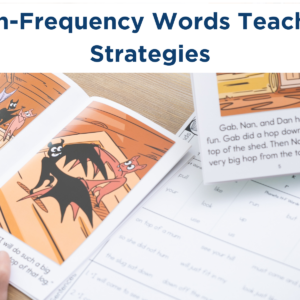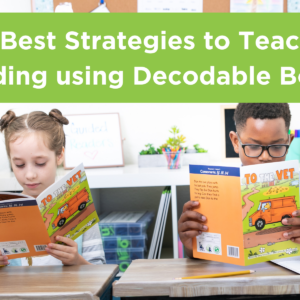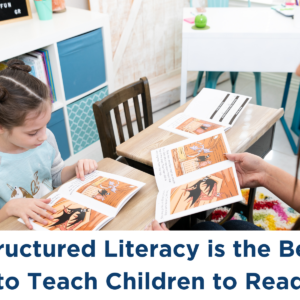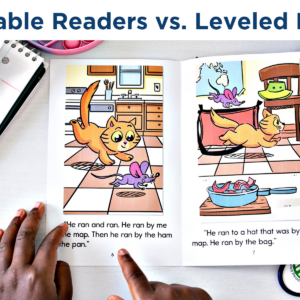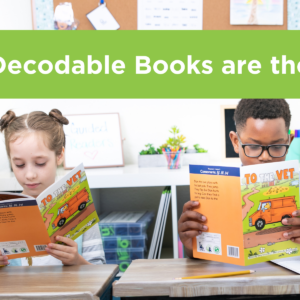Today we’re walking through the last Structured Literacy with EASE lesson we’re introducing to you as part of our walkthrough of the program blog series.
If this is your first time hearing about the program, here is a quick overview.
Structured Literacy with EASE is a research-based program created based on both the Science of Reading and the Simple View of Reading. It addresses all the strands of Scarborough’s Reading Rope. The EASE in the program name stands for Explicit and Systematic Essentials.
The program is specifically designed to give you the tools, lessons, and strategies to implement a solid Structured Literacy framework during small-group instruction to help your students learn the code and begin their journey to reading for meaning.
There are four types of lessons within the program:
- Isolated Sounds
- Spelling Rules
- Affixes
- Syllable Types & Division Rules
If this is the first post you’re seeing, you can check out the previous walkthroughs here:
- Walkthrough Structured Literacy with EASE Part 1
- Walkthrough of Structured Literacy with EASE Part 2
- Walkthrough of Structured Literacy with EASE Part 3
- Structured Literacy Sequence 1 Lesson 2
- Structured Literacy Sequence 2 Lesson 2 Spelling Rules
- Structured Literacy Sequence 3 Lesson 23
Sequence 4, Lesson 36 Walkthrough
There are two different Syllable Type lessons included in Structured Literacy with EASE. The first is a Syllable Type lesson, and the second is a Syllable Sort Lesson. Today we’re walking through Sequence 4, Lesson 36, one of the program’s Syllable Sort lessons.
The Syllable Type lessons are one-day lessons that don’t include a decodable book. The Syllable Sort lessons, like I’ll show you today, are two-day lessons that incorporate a decodable book similar to the other types of lessons in the program.
Let’s jump into this Syllable Sort lesson.
Day 1 Lesson Plan
We begin the Syllable Sort lesson by reviewing any high-frequency words the students haven’t mastered up until this point. Similar to the previous lessons we’ve walked through, we review these words through word mapping.
At this point in the program, students have been introduced to all 358 high-frequency words that at part of our EASE word list. This list includes some Fry words, Dulch words, and the 109 most common high-frequency words students will see in books they read.
So we’ll continue reviewing any high-frequency words students haven’t mastered yet.
Next, we introduce the focus skill for the lesson. In this particular lesson, students conduct a syllable sort after learning each syllable type. So we begin with explicit instruction on each of the seven syllable types.
The syllable sort for this lesson includes the mapping of syllables. This is something you won’t see in any other program. We invented this activity for the Structured Literacy with EASE program. Students map syllable types, which helps students become masterful at understanding syllable types and where words divide into syllables.
It’s an interesting part of the program that allows students to really understand how syllables break apart.
We end the lesson with a scaffolded application of the skill. Students use decoding and encoding as part of the application. This is the lesson portion where the skill sticks and mastery occurs.
At this point in the program, students decode words, phrases, and sentences. We’re no longer focused solely on isolated sounds because we’re through the entire program, and students have mastered individual sounds. They are ready to focus on decoding words, phrases, and sentences that include the focus skill for the lesson.
Day 2
We start day two the same way we started the previous day, using word mapping to review high-frequency words, heart words, and wise words from the program.
Next, we move into the scaffolded application of the skill for the lesson by introducing the decodable book that matches the lesson.
At this point in the program, you’ll notice that the decodable books are a little longer than in previous lessons, which allows the decodable books to have incredible character development. The books also scaffold and spiral in all skills and high-frequency words. So, you’ll see that as the students progress through the program, the books get progressively longer and more complex. We’re helping students become masterful decoders and fluent readers.
After reading the decodable book, students apply the skill they’re learning through another syllable sort activity based on their learned syllable types. This late in the program, we’ve taught all the different syllable types, and students can apply those skills and practice noticing what syllables are in individual words.
So again, Sequence 4, Lesson 36 is a two-day lesson. So it’s much quicker to work through the previous lessons we’ve walked through in the program.
The benefits of Structured Literacy with EASE
As mentioned, we’ve aligned the Structured Literacy with EASE program to all Scarborough’s Reading Rope strands. Hopefully, this walkthrough, and the others, have shown you the scaffolded and spiral approach the program uses to successfully guide students from learning the code to reading for meaning.
You can download the program information and Explicit Scope and Sequence here to learn more.





